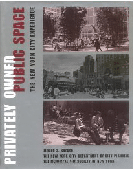New York Times reporter David Dunlap writes about the disappearance of The Berlin Wall at this POPS.

520 Madison Avenue
Public art and public spaces are constant collaborators in the city. For the art, a public space can serve as an ideal exhibition platform, drawing chance and committed observers alike on a daily basis. For the space, public art can provide an instant identity, supplying an inherently unique element to what is often a standard presentation of amenities. In examining the collaboration between public space and public art, the question of context is unusually important. Does the artwork advance an understanding of the space? Does the space contribute to an understanding of the art? Are the two arbitrarily placed in juxtaposition? Does the juxtaposition actually harm one or the other?

A 1990s addition to this urban plaza, a small rectangular space in a notched area of the building on the north side of East 53rd Street west of Madison Avenue, dramatically poses such questions. Five large reinforced concrete slabs taken from the demolished Berlin Wall, literally pieces of history, have been planted upright near the western edge of the space. Inscribed with garish, colored images of grim faces and graffiti, the slabs powerfully convey the sense of desolation and alienation presumably felt by those divided by the wall. The work is known as The Berlin Wall, created by artists Thierry Noir and Kiddy Citny, and falls squarely within a venerable public art tradition of jolting viewers out of their routine ways of thinking.
Does this art work well at this public space, however? As installed, the concrete slabs essentially take it over. The Berlin Wall now, ironically, separates the urban plaza from its most salient, valuable amenity, a four-paneled water wall and reflecting pool lining the western edge. The naturalistic ambience of nine loosely arrayed trees and cobblestone paving, reminiscent of nearby, tranquil Paley Park, seems at odds with the in-your-face history lesson. Placed in close quarters with movable white wire-mesh café chairs and tables, heavily used for lunchtime eating, the slabs may lessen the prosaic pleasures of lunch or be trivialized by the activities of public space users. Perhaps the owner of the building viewed these slabs as an outdoor extension of artwork it has showcased for many years in its adjacent private office lobby.
The other public space here is sidewalk widening that virtually encircles the building on East 53rd Street, the west side of Madison Avenue, and the south side of East 54th Street. At a recent site visit, an open air café had installed tables and chairs on East 54th Street. No record of City approval has been found.



The restaurant menue and make it look as if the seating is part of a private space for patrons only.
Hello,
I am interested in putting up a mural above the waterfall on the side of the building 9 E. 53rd Street. I have the building manager’s approval and rate, however heard from their neighbor, Tishman Speyer, that there are regulations for this. Can you please call me back to discuss?